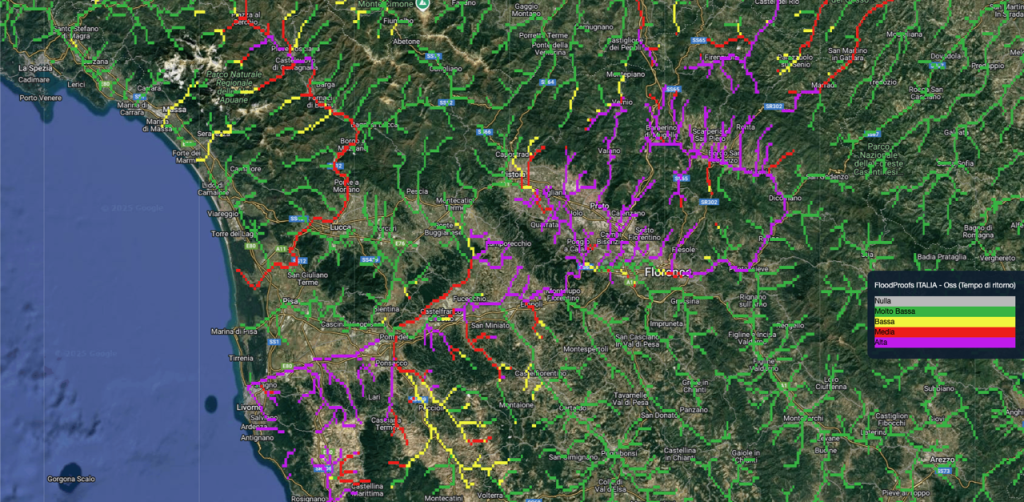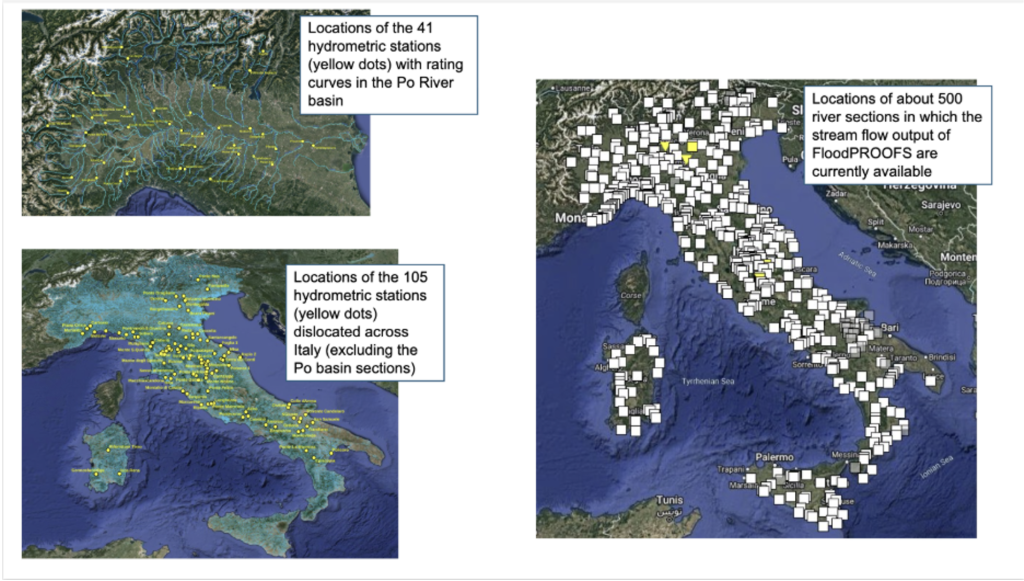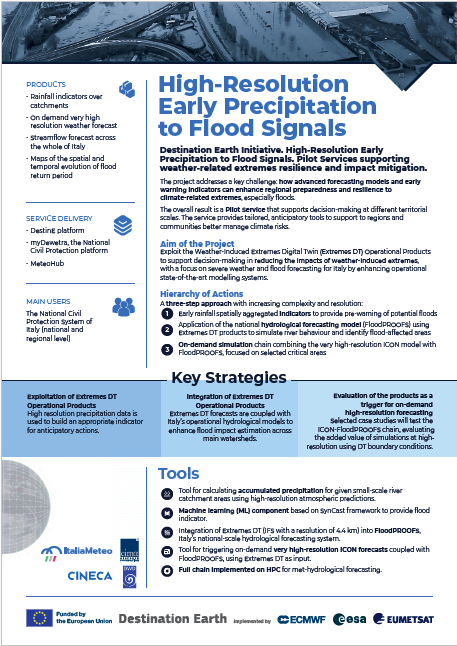
Pilot Service – High-Resolution Precipitation-to-Flood Signals
High-resolution precipitation forecasts using Destination Earth
Main contractor: Agenzia ItaliaMeteo (Italy)
What is it? Provide flood information for the Italian territory using high spatial and temporal resolution data from the Weather-Induced Extremes Digital Twin (Extremes DT) combined with hydrological models and ICON predictions, a model which comprises component models for the land, ocean and atmosphere
Concrete applications examples:
Support decision-making to reduce the impacts of flooding caused by precipitation in Italy, with approaches adapted to the territorial and socioeconomic context of different locations. This Pilot Service also anticipates early detection of flood risks by possible river overflows over small and medium catchments, using machine learning (ML) enhanced indicators.
The system will include the full chain of the targeted extreme event, from rainfall indicators to indications for potential floods.
Main target end users:
Italy’s National Civil Protection System and Italian Regional Functional Centres.

The Flood Signals Pilot Service aims at providing enhanced river flow information at high spatial resolution, for rivers in a particular Italian river network, triggered by precipitation indicators.
Factsheet: Click the photo below to view the full PDF factsheet on the Pilot Service – High-Resolution Precipitation-to-Flood Signals.
Digital twin data for flood risk management in Italy
To provide this new DestinE Pilot Service, Agenzia ItaliaMeteo is joining forces with Germany’s Deutscher Wetterdienst, CIMA Research Foundation, a leader institution supporting Italy’s National Civil Protection with hydrology simulations, warning systems, communication and data management, and CINECA, hosting Italy’s largest supercomputing centre – Leonardo.
The team aims to pilot deriving detailed information of flooding potential, including through the use of an on-demand model workflow for selected regions in Italy.
The pilot service exploits the DestinE Extremes DT products in two main complementary components:
First, it will calculate accumulated precipitation for Italian river catchments based on the high-resolution atmospheric predictions of the digital twin, combined with a hydrological interface that will estimate the water inflow into the river catchments, to understand how precipitation accumulates withing these areas.
Second, using machine learning (ML) the system will also integrate measurements from gauging stations and other sensors, helping calibrate the influence of precipitation in a given river catchment and adapting to local hydrologic conditions for enhanced accuracy.

The information will be integrated into national forecasting systems merging the data provided by FloodPROOFS, a hydrologic model covering the entire Italian territory at a spatial resolution of 500m, and the high-resolution weather data provided by the Extremes DT. The integration will enhance the flood modelling capabilities, providing improved geographical information on the location and intensity of flood forecasts. Italy’s National Civil Protection System will benefit from this multi-model approach, homogeneous at the national level.
In addition, the team will evaluate the Pilot Service products to demonstrate their added value. Performed for selected case studies across Italy, this will help assess the usability of the products for triggering on-demand high-resolution forecasts using the Extremes DT simulations as boundary conditions. Users will be engaged in a co-creation process from the very beginning of the project.
ECMWF, as a key implementing entity of the Destination Earth initiative of the European Union, has issued a series of Pilot Services contracts that demonstrate the added value of the Weather-Induced Extremes Digital Twin and the Climate Change Adaptation Digital Twin, and the wider DestinE architecture. The key target users of the Pilot Services are the sectors most impacted by climate change and weather extremes, such as maritime operations, coastal areas, energy, and more. The contracts include a specific call for machine learning and artificial intelligence-based proposals as a part of the implementation of ML/AI techniques within the Destination Earth initiative of the European Commission, led by DG CNECT, and implemented by ECMWF, EUMETSAT, ESA and over 100 partner institutions across Europe.
Copyright title image: AdobeStock makasana photo
